CP1126: Business Information Systems Financial Management Report
VerifiedAdded on 2021/03/22
|10
|2642
|91
Report
AI Summary
This report provides a comprehensive overview of financial management within Business Information Systems, specifically addressing the topics of inventory and trade receivables. It defines these terms and describes how information systems, such as stock control and point-of-sale systems, provide data for their calculation in financial statements. The report then delves into the application of finance and accounting techniques within an IS/IT function, discussing departmental budgeting and control, project planning, business case development, benefits monitoring, and contracts and financing. It explains how these techniques are utilized, providing justified reasons for their consideration and use within the context of IS/IT projects and operations, including the importance of project budgets, support budgets, and the role of business cases in justifying new projects. The report also emphasizes the importance of monitoring project benefits and the role of contracts and financing in acquiring necessary resources.
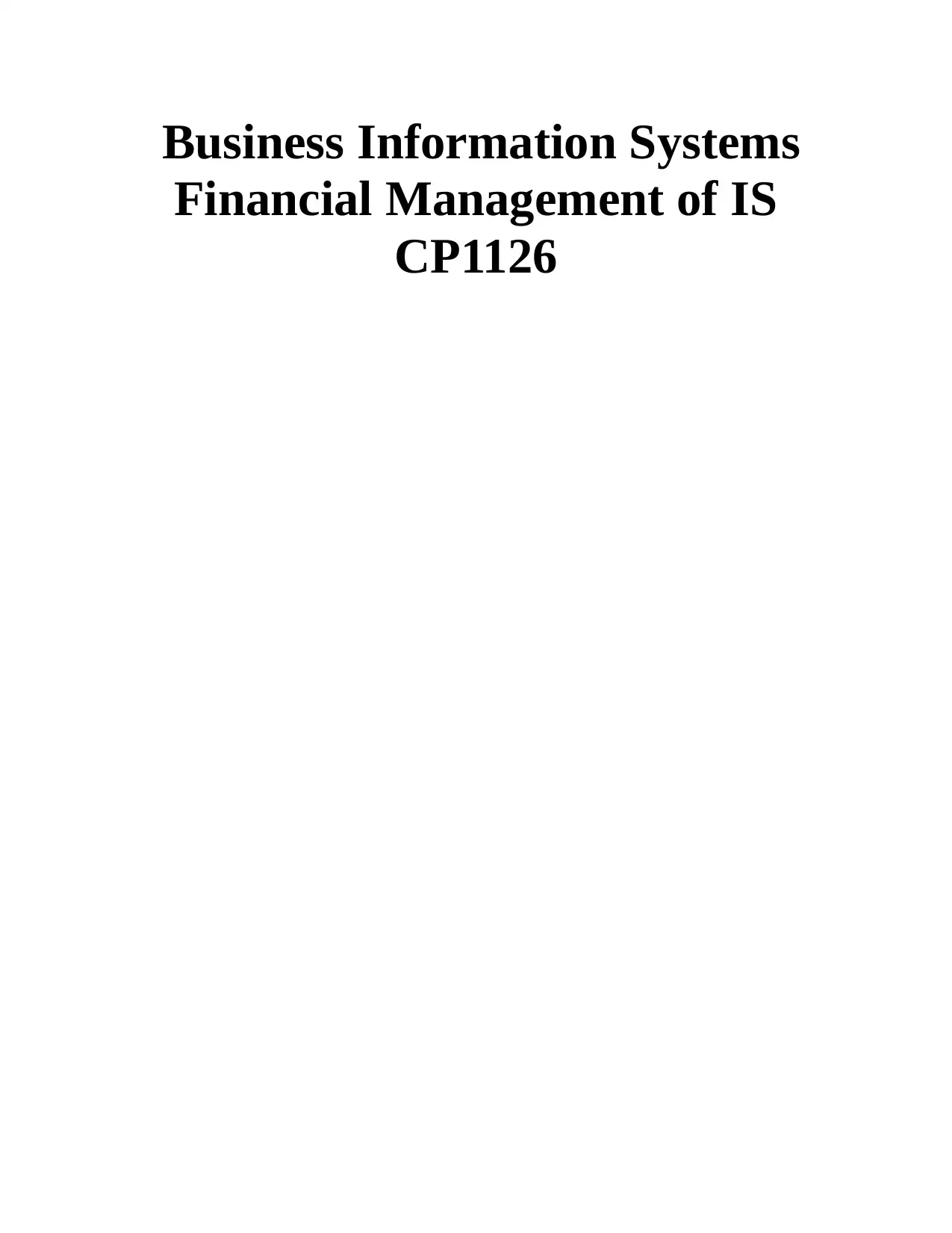
Business Information Systems
Financial Management of IS
CP1126
Financial Management of IS
CP1126
Paraphrase This Document
Need a fresh take? Get an instant paraphrase of this document with our AI Paraphraser
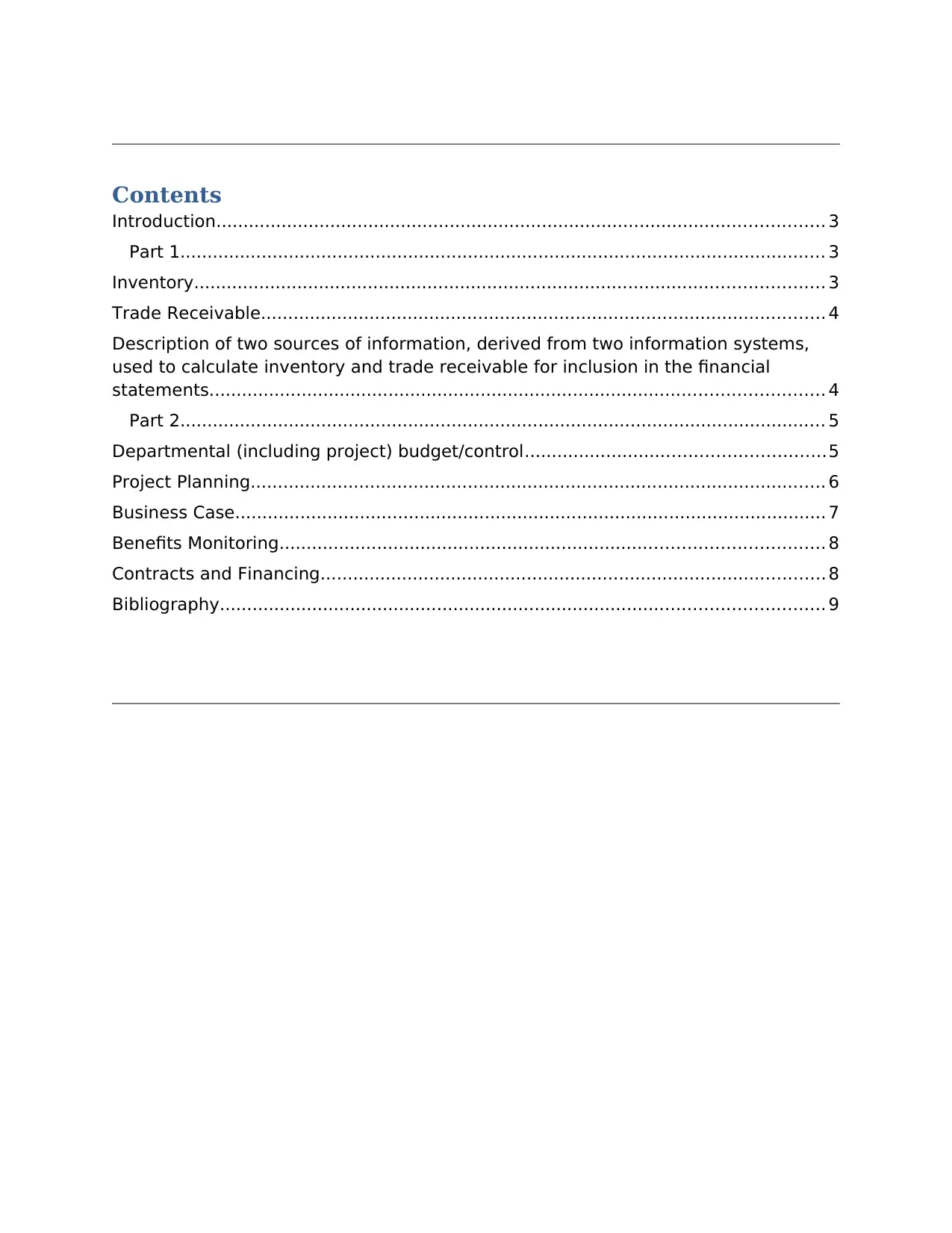
Contents
Introduction................................................................................................................ 3
Part 1....................................................................................................................... 3
Inventory.................................................................................................................... 3
Trade Receivable........................................................................................................ 4
Description of two sources of information, derived from two information systems,
used to calculate inventory and trade receivable for inclusion in the financial
statements................................................................................................................. 4
Part 2....................................................................................................................... 5
Departmental (including project) budget/control.......................................................5
Project Planning.......................................................................................................... 6
Business Case............................................................................................................. 7
Benefits Monitoring.................................................................................................... 8
Contracts and Financing............................................................................................. 8
Bibliography............................................................................................................... 9
Introduction................................................................................................................ 3
Part 1....................................................................................................................... 3
Inventory.................................................................................................................... 3
Trade Receivable........................................................................................................ 4
Description of two sources of information, derived from two information systems,
used to calculate inventory and trade receivable for inclusion in the financial
statements................................................................................................................. 4
Part 2....................................................................................................................... 5
Departmental (including project) budget/control.......................................................5
Project Planning.......................................................................................................... 6
Business Case............................................................................................................. 7
Benefits Monitoring.................................................................................................... 8
Contracts and Financing............................................................................................. 8
Bibliography............................................................................................................... 9
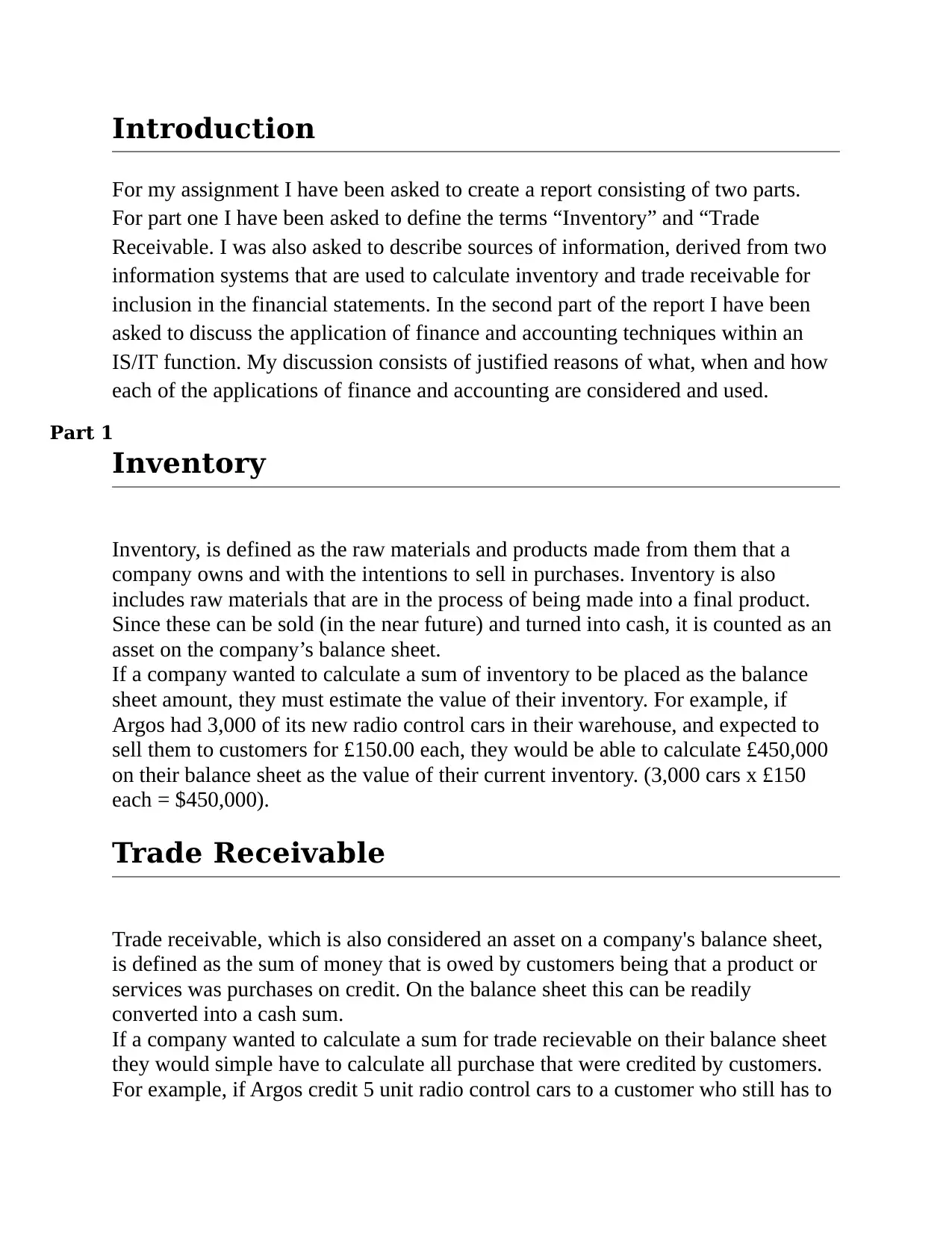
Introduction
For my assignment I have been asked to create a report consisting of two parts.
For part one I have been asked to define the terms “Inventory” and “Trade
Receivable. I was also asked to describe sources of information, derived from two
information systems that are used to calculate inventory and trade receivable for
inclusion in the financial statements. In the second part of the report I have been
asked to discuss the application of finance and accounting techniques within an
IS/IT function. My discussion consists of justified reasons of what, when and how
each of the applications of finance and accounting are considered and used.
Part 1
Inventory
Inventory, is defined as the raw materials and products made from them that a
company owns and with the intentions to sell in purchases. Inventory is also
includes raw materials that are in the process of being made into a final product.
Since these can be sold (in the near future) and turned into cash, it is counted as an
asset on the company’s balance sheet.
If a company wanted to calculate a sum of inventory to be placed as the balance
sheet amount, they must estimate the value of their inventory. For example, if
Argos had 3,000 of its new radio control cars in their warehouse, and expected to
sell them to customers for £150.00 each, they would be able to calculate £450,000
on their balance sheet as the value of their current inventory. (3,000 cars x £150
each = $450,000).
Trade Receivable
Trade receivable, which is also considered an asset on a company's balance sheet,
is defined as the sum of money that is owed by customers being that a product or
services was purchases on credit. On the balance sheet this can be readily
converted into a cash sum.
If a company wanted to calculate a sum for trade recievable on their balance sheet
they would simple have to calculate all purchase that were credited by customers.
For example, if Argos credit 5 unit radio control cars to a customer who still has to
For my assignment I have been asked to create a report consisting of two parts.
For part one I have been asked to define the terms “Inventory” and “Trade
Receivable. I was also asked to describe sources of information, derived from two
information systems that are used to calculate inventory and trade receivable for
inclusion in the financial statements. In the second part of the report I have been
asked to discuss the application of finance and accounting techniques within an
IS/IT function. My discussion consists of justified reasons of what, when and how
each of the applications of finance and accounting are considered and used.
Part 1
Inventory
Inventory, is defined as the raw materials and products made from them that a
company owns and with the intentions to sell in purchases. Inventory is also
includes raw materials that are in the process of being made into a final product.
Since these can be sold (in the near future) and turned into cash, it is counted as an
asset on the company’s balance sheet.
If a company wanted to calculate a sum of inventory to be placed as the balance
sheet amount, they must estimate the value of their inventory. For example, if
Argos had 3,000 of its new radio control cars in their warehouse, and expected to
sell them to customers for £150.00 each, they would be able to calculate £450,000
on their balance sheet as the value of their current inventory. (3,000 cars x £150
each = $450,000).
Trade Receivable
Trade receivable, which is also considered an asset on a company's balance sheet,
is defined as the sum of money that is owed by customers being that a product or
services was purchases on credit. On the balance sheet this can be readily
converted into a cash sum.
If a company wanted to calculate a sum for trade recievable on their balance sheet
they would simple have to calculate all purchase that were credited by customers.
For example, if Argos credit 5 unit radio control cars to a customer who still has to
⊘ This is a preview!⊘
Do you want full access?
Subscribe today to unlock all pages.

Trusted by 1+ million students worldwide
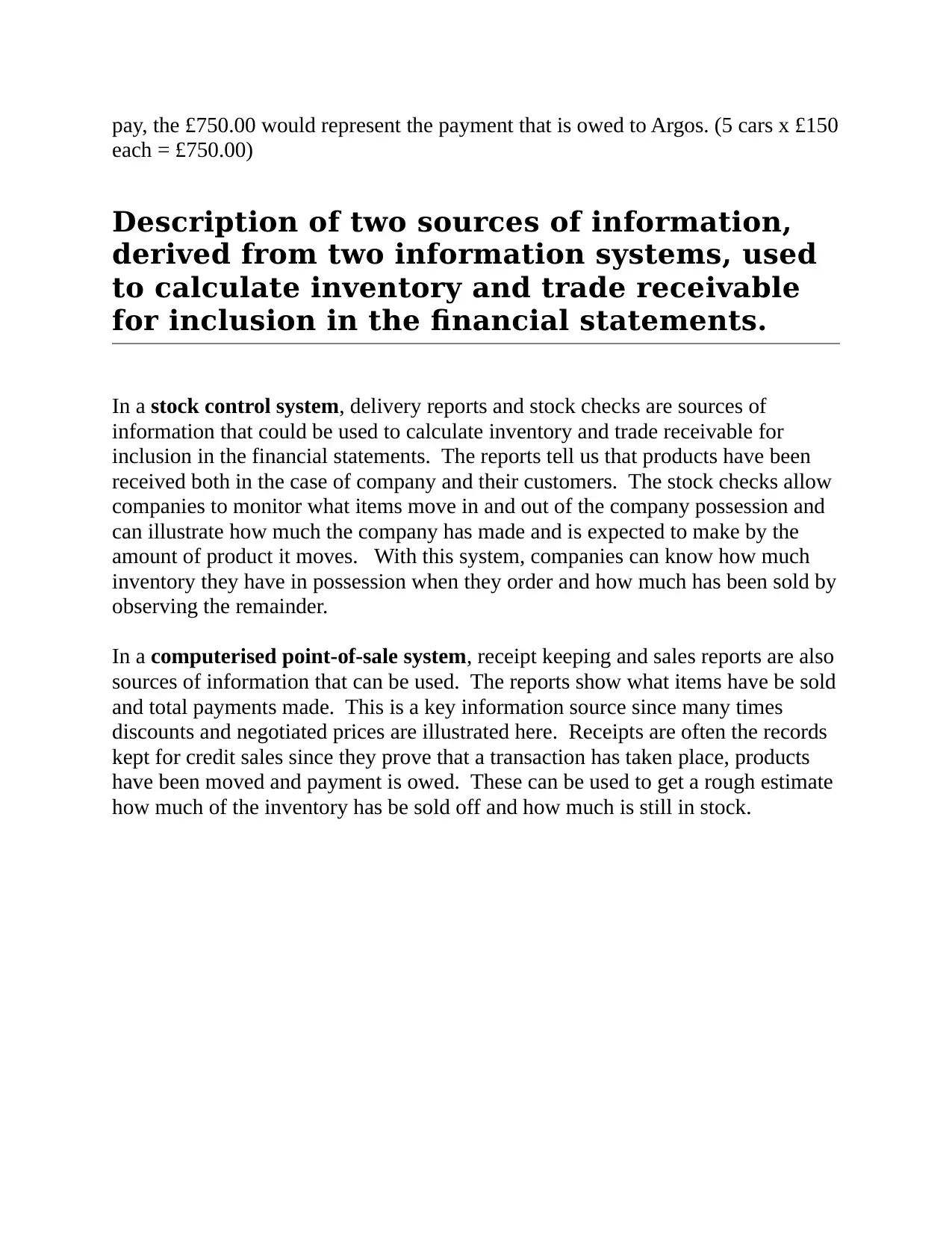
pay, the £750.00 would represent the payment that is owed to Argos. (5 cars x £150
each = £750.00)
Description of two sources of information,
derived from two information systems, used
to calculate inventory and trade receivable
for inclusion in the financial statements.
In a stock control system, delivery reports and stock checks are sources of
information that could be used to calculate inventory and trade receivable for
inclusion in the financial statements. The reports tell us that products have been
received both in the case of company and their customers. The stock checks allow
companies to monitor what items move in and out of the company possession and
can illustrate how much the company has made and is expected to make by the
amount of product it moves. With this system, companies can know how much
inventory they have in possession when they order and how much has been sold by
observing the remainder.
In a computerised point-of-sale system, receipt keeping and sales reports are also
sources of information that can be used. The reports show what items have be sold
and total payments made. This is a key information source since many times
discounts and negotiated prices are illustrated here. Receipts are often the records
kept for credit sales since they prove that a transaction has taken place, products
have been moved and payment is owed. These can be used to get a rough estimate
how much of the inventory has be sold off and how much is still in stock.
each = £750.00)
Description of two sources of information,
derived from two information systems, used
to calculate inventory and trade receivable
for inclusion in the financial statements.
In a stock control system, delivery reports and stock checks are sources of
information that could be used to calculate inventory and trade receivable for
inclusion in the financial statements. The reports tell us that products have been
received both in the case of company and their customers. The stock checks allow
companies to monitor what items move in and out of the company possession and
can illustrate how much the company has made and is expected to make by the
amount of product it moves. With this system, companies can know how much
inventory they have in possession when they order and how much has been sold by
observing the remainder.
In a computerised point-of-sale system, receipt keeping and sales reports are also
sources of information that can be used. The reports show what items have be sold
and total payments made. This is a key information source since many times
discounts and negotiated prices are illustrated here. Receipts are often the records
kept for credit sales since they prove that a transaction has taken place, products
have been moved and payment is owed. These can be used to get a rough estimate
how much of the inventory has be sold off and how much is still in stock.
Paraphrase This Document
Need a fresh take? Get an instant paraphrase of this document with our AI Paraphraser
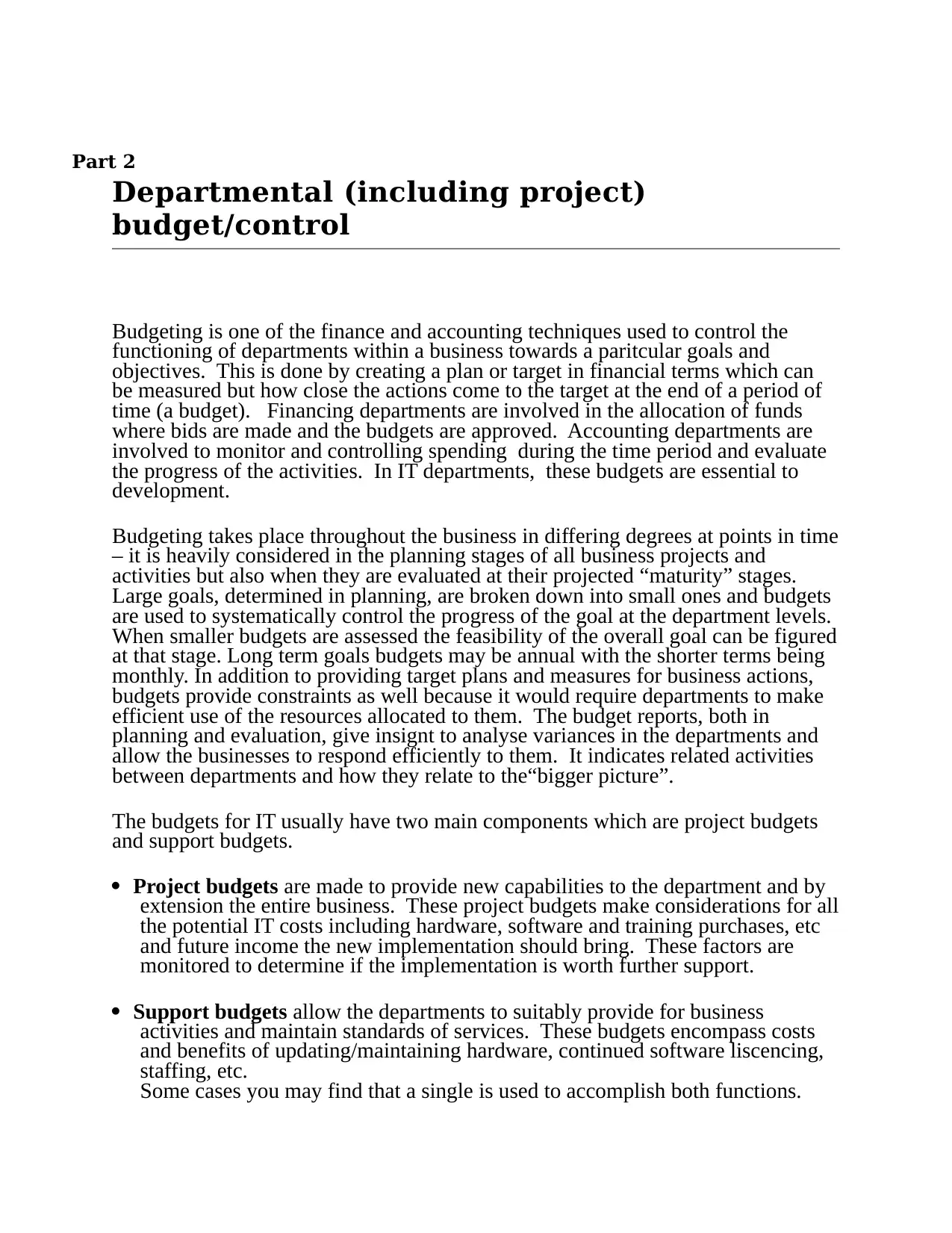
Part 2
Departmental (including project)
budget/control
Budgeting is one of the finance and accounting techniques used to control the
functioning of departments within a business towards a paritcular goals and
objectives. This is done by creating a plan or target in financial terms which can
be measured but how close the actions come to the target at the end of a period of
time (a budget). Financing departments are involved in the allocation of funds
where bids are made and the budgets are approved. Accounting departments are
involved to monitor and controlling spending during the time period and evaluate
the progress of the activities. In IT departments, these budgets are essential to
development.
Budgeting takes place throughout the business in differing degrees at points in time
– it is heavily considered in the planning stages of all business projects and
activities but also when they are evaluated at their projected “maturity” stages.
Large goals, determined in planning, are broken down into small ones and budgets
are used to systematically control the progress of the goal at the department levels.
When smaller budgets are assessed the feasibility of the overall goal can be figured
at that stage. Long term goals budgets may be annual with the shorter terms being
monthly. In addition to providing target plans and measures for business actions,
budgets provide constraints as well because it would require departments to make
efficient use of the resources allocated to them. The budget reports, both in
planning and evaluation, give insignt to analyse variances in the departments and
allow the businesses to respond efficiently to them. It indicates related activities
between departments and how they relate to the“bigger picture”.
The budgets for IT usually have two main components which are project budgets
and support budgets.
Project budgets are made to provide new capabilities to the department and by
extension the entire business. These project budgets make considerations for all
the potential IT costs including hardware, software and training purchases, etc
and future income the new implementation should bring. These factors are
monitored to determine if the implementation is worth further support.
Support budgets allow the departments to suitably provide for business
activities and maintain standards of services. These budgets encompass costs
and benefits of updating/maintaining hardware, continued software liscencing,
staffing, etc.
Some cases you may find that a single is used to accomplish both functions.
Departmental (including project)
budget/control
Budgeting is one of the finance and accounting techniques used to control the
functioning of departments within a business towards a paritcular goals and
objectives. This is done by creating a plan or target in financial terms which can
be measured but how close the actions come to the target at the end of a period of
time (a budget). Financing departments are involved in the allocation of funds
where bids are made and the budgets are approved. Accounting departments are
involved to monitor and controlling spending during the time period and evaluate
the progress of the activities. In IT departments, these budgets are essential to
development.
Budgeting takes place throughout the business in differing degrees at points in time
– it is heavily considered in the planning stages of all business projects and
activities but also when they are evaluated at their projected “maturity” stages.
Large goals, determined in planning, are broken down into small ones and budgets
are used to systematically control the progress of the goal at the department levels.
When smaller budgets are assessed the feasibility of the overall goal can be figured
at that stage. Long term goals budgets may be annual with the shorter terms being
monthly. In addition to providing target plans and measures for business actions,
budgets provide constraints as well because it would require departments to make
efficient use of the resources allocated to them. The budget reports, both in
planning and evaluation, give insignt to analyse variances in the departments and
allow the businesses to respond efficiently to them. It indicates related activities
between departments and how they relate to the“bigger picture”.
The budgets for IT usually have two main components which are project budgets
and support budgets.
Project budgets are made to provide new capabilities to the department and by
extension the entire business. These project budgets make considerations for all
the potential IT costs including hardware, software and training purchases, etc
and future income the new implementation should bring. These factors are
monitored to determine if the implementation is worth further support.
Support budgets allow the departments to suitably provide for business
activities and maintain standards of services. These budgets encompass costs
and benefits of updating/maintaining hardware, continued software liscencing,
staffing, etc.
Some cases you may find that a single is used to accomplish both functions.
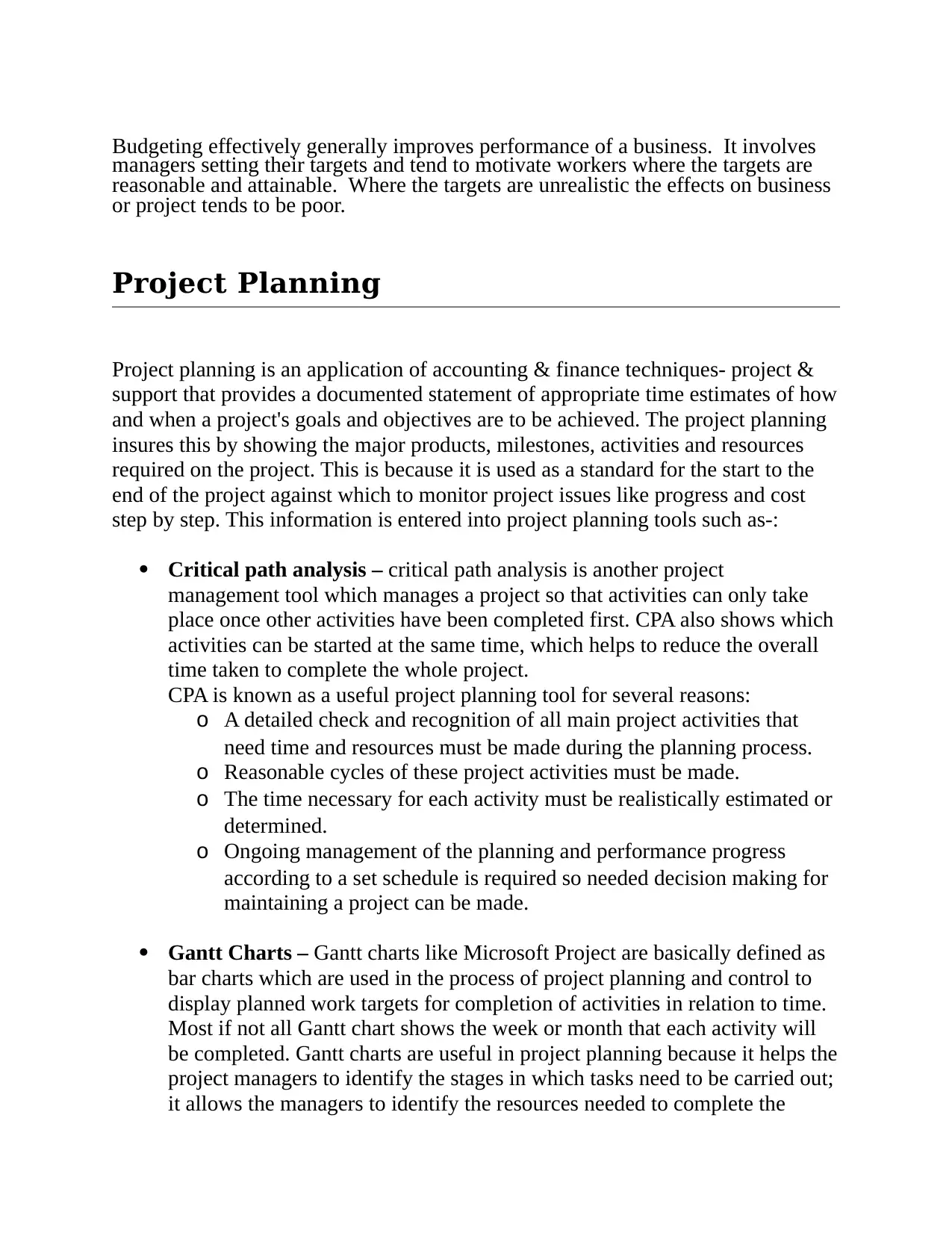
Budgeting effectively generally improves performance of a business. It involves
managers setting their targets and tend to motivate workers where the targets are
reasonable and attainable. Where the targets are unrealistic the effects on business
or project tends to be poor.
Project Planning
Project planning is an application of accounting & finance techniques- project &
support that provides a documented statement of appropriate time estimates of how
and when a project's goals and objectives are to be achieved. The project planning
insures this by showing the major products, milestones, activities and resources
required on the project. This is because it is used as a standard for the start to the
end of the project against which to monitor project issues like progress and cost
step by step. This information is entered into project planning tools such as-:
Critical path analysis – critical path analysis is another project
management tool which manages a project so that activities can only take
place once other activities have been completed first. CPA also shows which
activities can be started at the same time, which helps to reduce the overall
time taken to complete the whole project.
CPA is known as a useful project planning tool for several reasons:
o A detailed check and recognition of all main project activities that
need time and resources must be made during the planning process.
o Reasonable cycles of these project activities must be made.
o The time necessary for each activity must be realistically estimated or
determined.
o Ongoing management of the planning and performance progress
according to a set schedule is required so needed decision making for
maintaining a project can be made.
Gantt Charts – Gantt charts like Microsoft Project are basically defined as
bar charts which are used in the process of project planning and control to
display planned work targets for completion of activities in relation to time.
Most if not all Gantt chart shows the week or month that each activity will
be completed. Gantt charts are useful in project planning because it helps the
project managers to identify the stages in which tasks need to be carried out;
it allows the managers to identify the resources needed to complete the
managers setting their targets and tend to motivate workers where the targets are
reasonable and attainable. Where the targets are unrealistic the effects on business
or project tends to be poor.
Project Planning
Project planning is an application of accounting & finance techniques- project &
support that provides a documented statement of appropriate time estimates of how
and when a project's goals and objectives are to be achieved. The project planning
insures this by showing the major products, milestones, activities and resources
required on the project. This is because it is used as a standard for the start to the
end of the project against which to monitor project issues like progress and cost
step by step. This information is entered into project planning tools such as-:
Critical path analysis – critical path analysis is another project
management tool which manages a project so that activities can only take
place once other activities have been completed first. CPA also shows which
activities can be started at the same time, which helps to reduce the overall
time taken to complete the whole project.
CPA is known as a useful project planning tool for several reasons:
o A detailed check and recognition of all main project activities that
need time and resources must be made during the planning process.
o Reasonable cycles of these project activities must be made.
o The time necessary for each activity must be realistically estimated or
determined.
o Ongoing management of the planning and performance progress
according to a set schedule is required so needed decision making for
maintaining a project can be made.
Gantt Charts – Gantt charts like Microsoft Project are basically defined as
bar charts which are used in the process of project planning and control to
display planned work targets for completion of activities in relation to time.
Most if not all Gantt chart shows the week or month that each activity will
be completed. Gantt charts are useful in project planning because it helps the
project managers to identify the stages in which tasks need to be carried out;
it allows the managers to identify the resources needed to complete the
⊘ This is a preview!⊘
Do you want full access?
Subscribe today to unlock all pages.

Trusted by 1+ million students worldwide
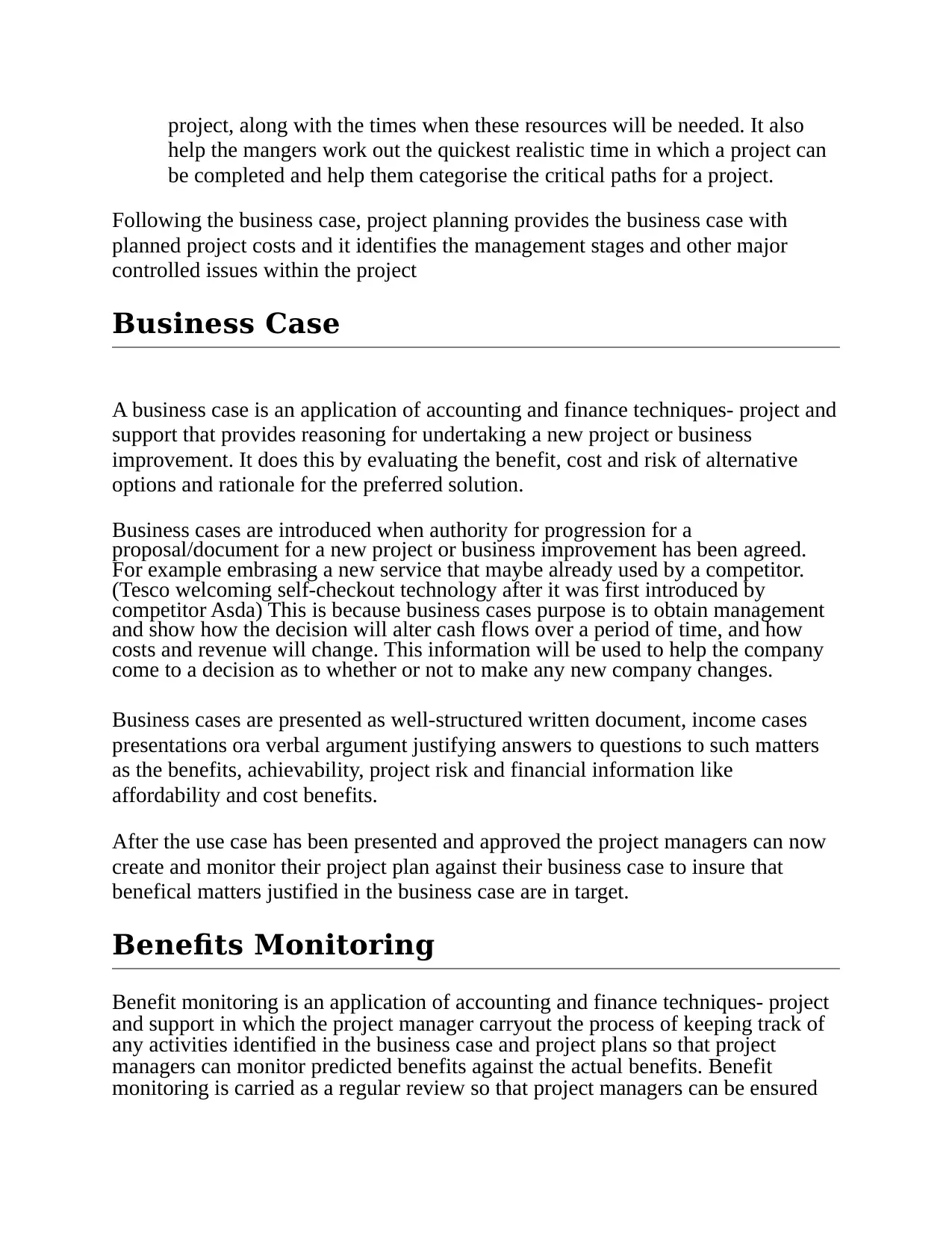
project, along with the times when these resources will be needed. It also
help the mangers work out the quickest realistic time in which a project can
be completed and help them categorise the critical paths for a project.
Following the business case, project planning provides the business case with
planned project costs and it identifies the management stages and other major
controlled issues within the project
Business Case
A business case is an application of accounting and finance techniques- project and
support that provides reasoning for undertaking a new project or business
improvement. It does this by evaluating the benefit, cost and risk of alternative
options and rationale for the preferred solution.
Business cases are introduced when authority for progression for a
proposal/document for a new project or business improvement has been agreed.
For example embrasing a new service that maybe already used by a competitor.
(Tesco welcoming self-checkout technology after it was first introduced by
competitor Asda) This is because business cases purpose is to obtain management
and show how the decision will alter cash flows over a period of time, and how
costs and revenue will change. This information will be used to help the company
come to a decision as to whether or not to make any new company changes.
Business cases are presented as well-structured written document, income cases
presentations ora verbal argument justifying answers to questions to such matters
as the benefits, achievability, project risk and financial information like
affordability and cost benefits.
After the use case has been presented and approved the project managers can now
create and monitor their project plan against their business case to insure that
benefical matters justified in the business case are in target.
Benefits Monitoring
Benefit monitoring is an application of accounting and finance techniques- project
and support in which the project manager carryout the process of keeping track of
any activities identified in the business case and project plans so that project
managers can monitor predicted benefits against the actual benefits. Benefit
monitoring is carried as a regular review so that project managers can be ensured
help the mangers work out the quickest realistic time in which a project can
be completed and help them categorise the critical paths for a project.
Following the business case, project planning provides the business case with
planned project costs and it identifies the management stages and other major
controlled issues within the project
Business Case
A business case is an application of accounting and finance techniques- project and
support that provides reasoning for undertaking a new project or business
improvement. It does this by evaluating the benefit, cost and risk of alternative
options and rationale for the preferred solution.
Business cases are introduced when authority for progression for a
proposal/document for a new project or business improvement has been agreed.
For example embrasing a new service that maybe already used by a competitor.
(Tesco welcoming self-checkout technology after it was first introduced by
competitor Asda) This is because business cases purpose is to obtain management
and show how the decision will alter cash flows over a period of time, and how
costs and revenue will change. This information will be used to help the company
come to a decision as to whether or not to make any new company changes.
Business cases are presented as well-structured written document, income cases
presentations ora verbal argument justifying answers to questions to such matters
as the benefits, achievability, project risk and financial information like
affordability and cost benefits.
After the use case has been presented and approved the project managers can now
create and monitor their project plan against their business case to insure that
benefical matters justified in the business case are in target.
Benefits Monitoring
Benefit monitoring is an application of accounting and finance techniques- project
and support in which the project manager carryout the process of keeping track of
any activities identified in the business case and project plans so that project
managers can monitor predicted benefits against the actual benefits. Benefit
monitoring is carried as a regular review so that project managers can be ensured
Paraphrase This Document
Need a fresh take? Get an instant paraphrase of this document with our AI Paraphraser
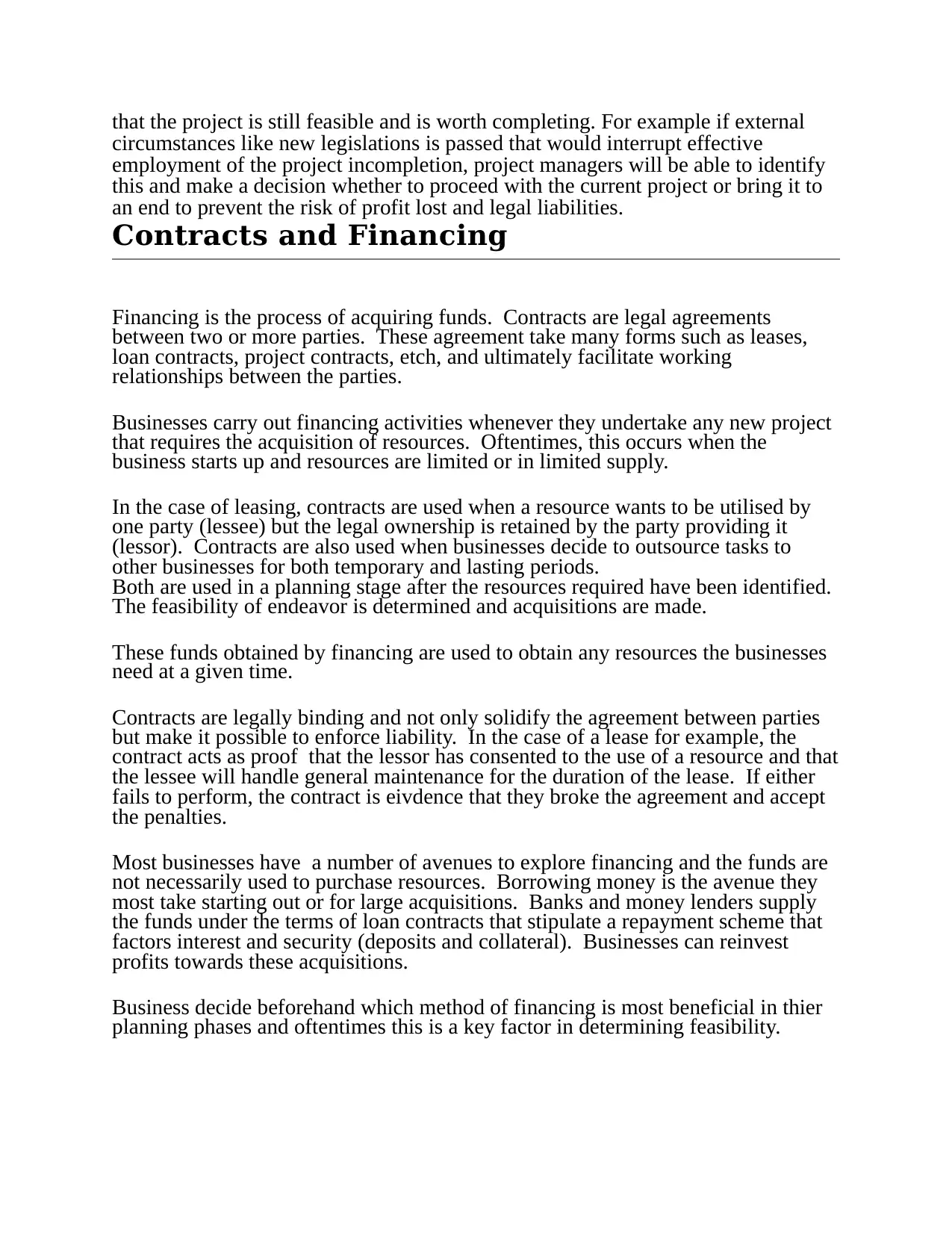
that the project is still feasible and is worth completing. For example if external
circumstances like new legislations is passed that would interrupt effective
employment of the project incompletion, project managers will be able to identify
this and make a decision whether to proceed with the current project or bring it to
an end to prevent the risk of profit lost and legal liabilities.
Contracts and Financing
Financing is the process of acquiring funds. Contracts are legal agreements
between two or more parties. These agreement take many forms such as leases,
loan contracts, project contracts, etch, and ultimately facilitate working
relationships between the parties.
Businesses carry out financing activities whenever they undertake any new project
that requires the acquisition of resources. Oftentimes, this occurs when the
business starts up and resources are limited or in limited supply.
In the case of leasing, contracts are used when a resource wants to be utilised by
one party (lessee) but the legal ownership is retained by the party providing it
(lessor). Contracts are also used when businesses decide to outsource tasks to
other businesses for both temporary and lasting periods.
Both are used in a planning stage after the resources required have been identified.
The feasibility of endeavor is determined and acquisitions are made.
These funds obtained by financing are used to obtain any resources the businesses
need at a given time.
Contracts are legally binding and not only solidify the agreement between parties
but make it possible to enforce liability. In the case of a lease for example, the
contract acts as proof that the lessor has consented to the use of a resource and that
the lessee will handle general maintenance for the duration of the lease. If either
fails to perform, the contract is eivdence that they broke the agreement and accept
the penalties.
Most businesses have a number of avenues to explore financing and the funds are
not necessarily used to purchase resources. Borrowing money is the avenue they
most take starting out or for large acquisitions. Banks and money lenders supply
the funds under the terms of loan contracts that stipulate a repayment scheme that
factors interest and security (deposits and collateral). Businesses can reinvest
profits towards these acquisitions.
Business decide beforehand which method of financing is most beneficial in thier
planning phases and oftentimes this is a key factor in determining feasibility.
circumstances like new legislations is passed that would interrupt effective
employment of the project incompletion, project managers will be able to identify
this and make a decision whether to proceed with the current project or bring it to
an end to prevent the risk of profit lost and legal liabilities.
Contracts and Financing
Financing is the process of acquiring funds. Contracts are legal agreements
between two or more parties. These agreement take many forms such as leases,
loan contracts, project contracts, etch, and ultimately facilitate working
relationships between the parties.
Businesses carry out financing activities whenever they undertake any new project
that requires the acquisition of resources. Oftentimes, this occurs when the
business starts up and resources are limited or in limited supply.
In the case of leasing, contracts are used when a resource wants to be utilised by
one party (lessee) but the legal ownership is retained by the party providing it
(lessor). Contracts are also used when businesses decide to outsource tasks to
other businesses for both temporary and lasting periods.
Both are used in a planning stage after the resources required have been identified.
The feasibility of endeavor is determined and acquisitions are made.
These funds obtained by financing are used to obtain any resources the businesses
need at a given time.
Contracts are legally binding and not only solidify the agreement between parties
but make it possible to enforce liability. In the case of a lease for example, the
contract acts as proof that the lessor has consented to the use of a resource and that
the lessee will handle general maintenance for the duration of the lease. If either
fails to perform, the contract is eivdence that they broke the agreement and accept
the penalties.
Most businesses have a number of avenues to explore financing and the funds are
not necessarily used to purchase resources. Borrowing money is the avenue they
most take starting out or for large acquisitions. Banks and money lenders supply
the funds under the terms of loan contracts that stipulate a repayment scheme that
factors interest and security (deposits and collateral). Businesses can reinvest
profits towards these acquisitions.
Business decide beforehand which method of financing is most beneficial in thier
planning phases and oftentimes this is a key factor in determining feasibility.
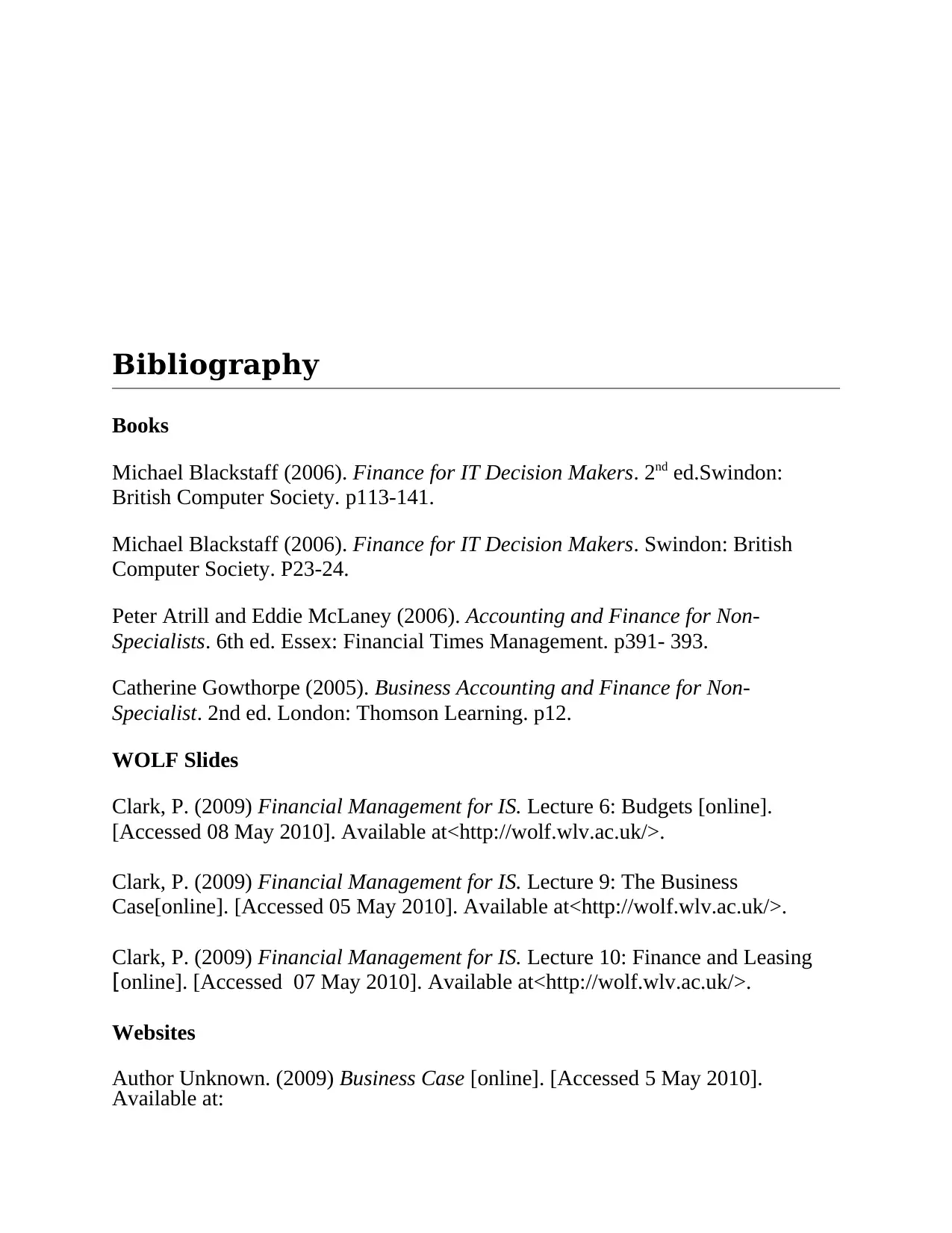
Bibliography
Books
Michael Blackstaff (2006). Finance for IT Decision Makers. 2nd ed.Swindon:
British Computer Society. p113-141.
Michael Blackstaff (2006). Finance for IT Decision Makers. Swindon: British
Computer Society. P23-24.
Peter Atrill and Eddie McLaney (2006). Accounting and Finance for Non-
Specialists. 6th ed. Essex: Financial Times Management. p391- 393.
Catherine Gowthorpe (2005). Business Accounting and Finance for Non-
Specialist. 2nd ed. London: Thomson Learning. p12.
WOLF Slides
Clark, P. (2009) Financial Management for IS. Lecture 6: Budgets [online].
[Accessed 08 May 2010]. Available at<http://wolf.wlv.ac.uk/>.
Clark, P. (2009) Financial Management for IS. Lecture 9: The Business
Case[online]. [Accessed 05 May 2010]. Available at<http://wolf.wlv.ac.uk/>.
Clark, P. (2009) Financial Management for IS. Lecture 10: Finance and Leasing
[online]. [Accessed 07 May 2010]. Available at<http://wolf.wlv.ac.uk/>.
Websites
Author Unknown. (2009) Business Case [online]. [Accessed 5 May 2010].
Available at:
Books
Michael Blackstaff (2006). Finance for IT Decision Makers. 2nd ed.Swindon:
British Computer Society. p113-141.
Michael Blackstaff (2006). Finance for IT Decision Makers. Swindon: British
Computer Society. P23-24.
Peter Atrill and Eddie McLaney (2006). Accounting and Finance for Non-
Specialists. 6th ed. Essex: Financial Times Management. p391- 393.
Catherine Gowthorpe (2005). Business Accounting and Finance for Non-
Specialist. 2nd ed. London: Thomson Learning. p12.
WOLF Slides
Clark, P. (2009) Financial Management for IS. Lecture 6: Budgets [online].
[Accessed 08 May 2010]. Available at<http://wolf.wlv.ac.uk/>.
Clark, P. (2009) Financial Management for IS. Lecture 9: The Business
Case[online]. [Accessed 05 May 2010]. Available at<http://wolf.wlv.ac.uk/>.
Clark, P. (2009) Financial Management for IS. Lecture 10: Finance and Leasing
[online]. [Accessed 07 May 2010]. Available at<http://wolf.wlv.ac.uk/>.
Websites
Author Unknown. (2009) Business Case [online]. [Accessed 5 May 2010].
Available at:
⊘ This is a preview!⊘
Do you want full access?
Subscribe today to unlock all pages.

Trusted by 1+ million students worldwide
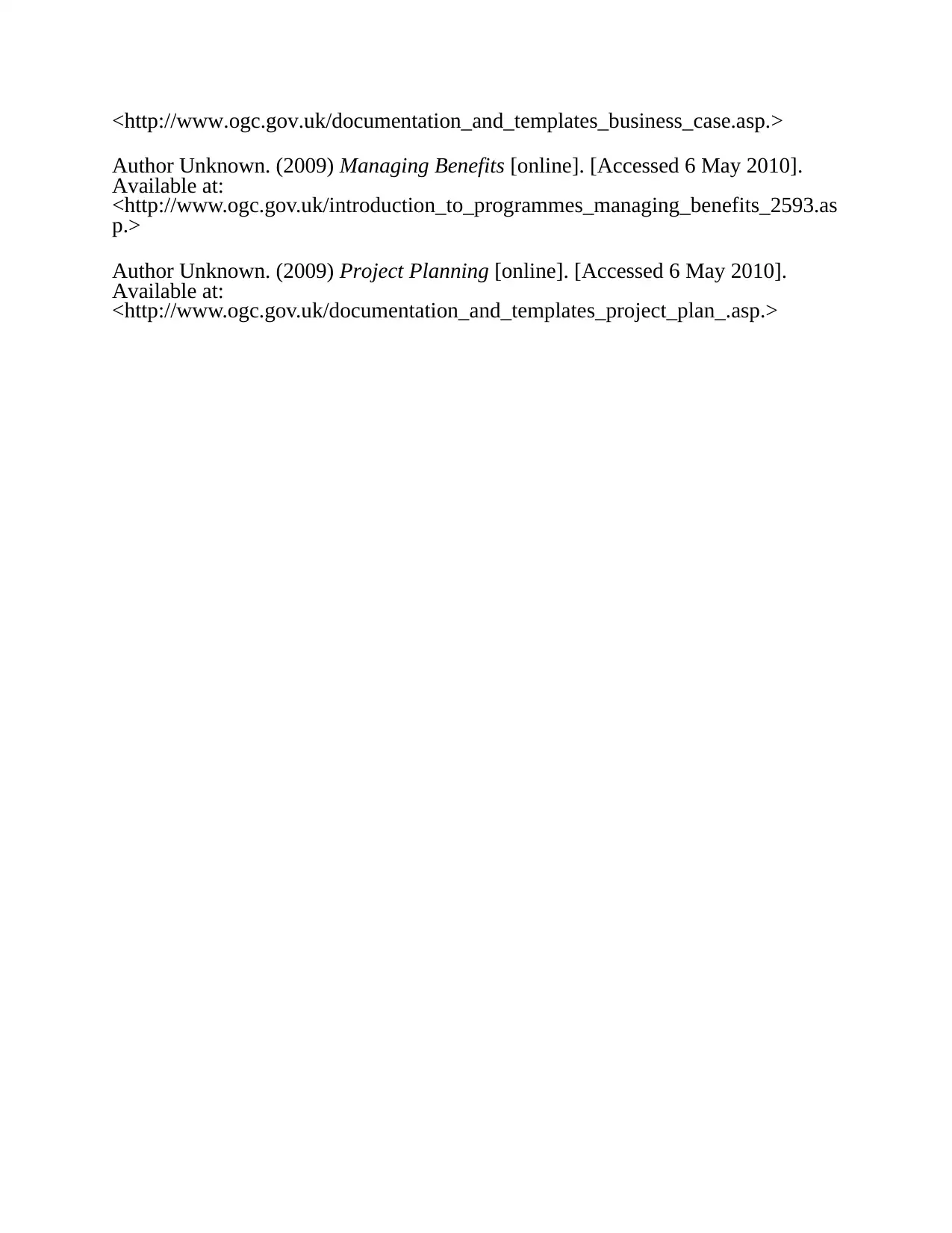
<http://www.ogc.gov.uk/documentation_and_templates_business_case.asp.>
Author Unknown. (2009) Managing Benefits [online]. [Accessed 6 May 2010].
Available at:
<http://www.ogc.gov.uk/introduction_to_programmes_managing_benefits_2593.as
p.>
Author Unknown. (2009) Project Planning [online]. [Accessed 6 May 2010].
Available at:
<http://www.ogc.gov.uk/documentation_and_templates_project_plan_.asp.>
Author Unknown. (2009) Managing Benefits [online]. [Accessed 6 May 2010].
Available at:
<http://www.ogc.gov.uk/introduction_to_programmes_managing_benefits_2593.as
p.>
Author Unknown. (2009) Project Planning [online]. [Accessed 6 May 2010].
Available at:
<http://www.ogc.gov.uk/documentation_and_templates_project_plan_.asp.>
1 out of 10
Related Documents
Your All-in-One AI-Powered Toolkit for Academic Success.
+13062052269
info@desklib.com
Available 24*7 on WhatsApp / Email
![[object Object]](/_next/static/media/star-bottom.7253800d.svg)
Unlock your academic potential
Copyright © 2020–2025 A2Z Services. All Rights Reserved. Developed and managed by ZUCOL.





